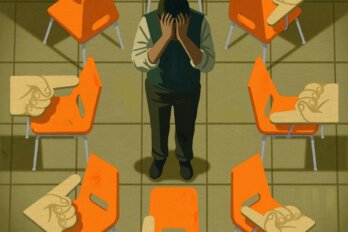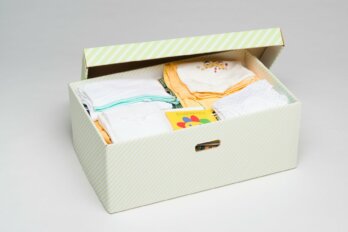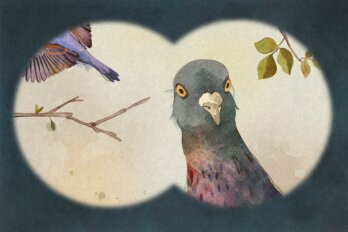In mid-September, photographer Jo-Anne McArthur drove to a turkey farm, six hours from her home in Toronto, to take some pictures. The farm comprised a half-dozen barns, each long and clean and new and bordered by well-tended flower gardens. Even arriving in the dead of night, as she did, McArthur could see that it was the kind of place, she told me later, “that a turkey farmer would be proud of.”
Inside the barns, which she entered through the windows, was a different story. Each barn was crowded with what she estimates must have been thousands of turkeys, each of them selectively bred to be as large as possible. In one barn, they were so enormous, and there were so many of them, that they could barely walk, let alone fly as their counterparts in the wild can. McArthur spent the next four hours in two of the barns. They were dim and airless and unbearably hot, and the turkeys mingled maniacally on the dusty floor. The heat made them pant. Turkeys are communicative birds, even in such distressing conditions, and they soon began to yelp and gobble. At first, just a couple of the birds, as if they were sounding an alarm, and then, suddenly, there was a swell of sound as seemingly every turkey in the barn joined this chorus. The wave crested and eventually fell, but as McArthur stood in the turkey’s midst, photographing them, individual birds kept up the chatter as they nosed around her legs. She marvelled, not for the first time, at their curiosity and friendliness. She noted, and took pictures of, several injured or dead birds, their bodies splayed on the floor. A few days after her visit, the rest of the birds would likely be sent to slaughter.
Over the last dozen years, McArthur has visited hundreds of facilities like this one, though visited isn’t quite the right word. McArthur, an animal-rights activist, is not usually welcome in these places or invited to them. She sneaks in or, on the rare occasions when permission is granted, walks into them in broad daylight to expose the horrors hidden within. She has photographed factory farms, slaughterhouses, laboratories, circuses, and zoos in more than sixty countries. In each one, she has taken intimate, revelatory, often brutal photographs of the animals that are raised or held captive in these places and whose lives usually end there. Her subjects have included pigs clubbed before slaughter in Thailand, bears caged in Laos, mink farms in Sweden, veal crates in Spain, greyhound races in Australia, veterinary schools in Spain, puppy mills in Canada, aquariums in Canada, and more. In just one trip to Taiwan last year, she visited twenty animal-use facilities to conduct investigations—her word for these arduous and traumatizing shoots—over the course of three weeks. Her photographs have appeared in National Geographic, the Washington Post, and Vice, but are used primarily by animal-rights organizations, educators, and legislators around the world. McArthur’s images helped lead to the 2017 conviction of a fur farmer in Quebec, the first animal-abuse conviction of a fur farmer in Canada. The Environment and Animal Society of Taiwan used her work in an effort to end fish tethering: the practice of tying a fish’s mouth to its tail, which is believed to keep it fresh longer out of water. “I’m extremely empathetic to all living creatures,” McArthur says. “I’m like a sponge, taking in the pain, joy, and worlds of those around me. I do this with animals, so I can’t just do nothing once I’ve seen how they’re living.”
Last year, McArthur launched We Animals Media (WAM), a nonprofit organization dedicated to this kind of investigative work. To distinguish it from wildlife or conservation photography, McArthur calls it “animal photojournalism,” an emergent genre that, in her words, “captures, memorializes, and exposes the experience of animals who live amongst us, but whom we fail to see.” WAM’s thousands of photographs, films, and videos—all free of charge to anyone who helps animals—represent possibly the largest archive of such images in the world. (The organization is bankrolled by donors and by grants from the likes of the Open Philanthropy Project, an American foundation focused on global health and scientific research.) While McArthur still regularly shoots for WAM, and the majority of its images are hers, she says contributors to the organization now include dozens of international photographers, filmmakers, writers, and activists. “Hopefully, eventually, there’ll be no more need for the archive,” she says. “It’ll literally be an archive, a historical, closed archive of what was and should never again be. Hopefully, in my lifetime.” McArthur has also published two books and, this month, released her third, Hidden: Animals in the Anthropocene. Co-edited with Keith Wilson, cofounder of Photographers Against Wildlife Crime, it’s a lavish collection of searing, upsetting images by some forty international documentary photographers, depicting animals used in agriculture, entertainment, and science. Britta Jaschinski, an acclaimed London-based wildlife photographer, provided several images and helped prepare the book for publication. “I will not miss an opportunity to give a voice to these sentient beings,” Jaschinski tells me, “and draw attention to the endless suffering humans are creating.”
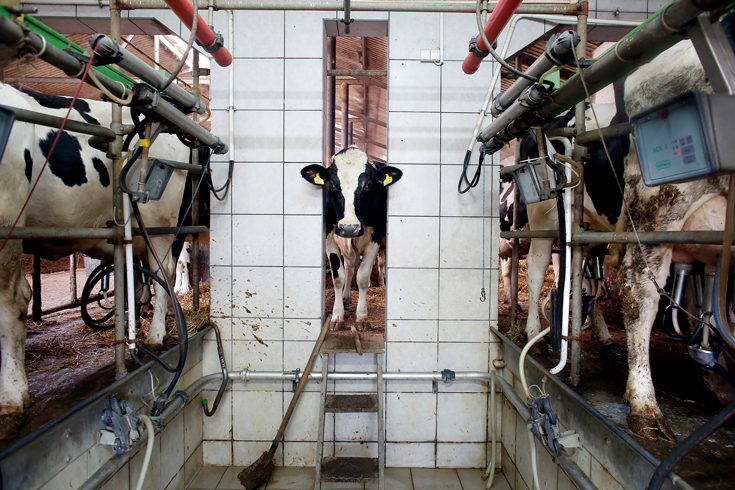
McArthur’s work has always been challenging to do. But, in the past couple of years, especially in Canada, it has become even more difficult. Last year, Alberta passed the Trespass Statutes (Protecting Law-Abiding Property Owners) Amendment Act, a series of amendments to existing trespass laws, and in June, the Ontario government passed similar legislation, Bill 156, the Security from Trespass and Protecting Food Safety Act. Both bills effectively made it illegal for whistleblowers, whom the campaigners McArthur works with rely on, to expose animal abuse and neglect on farms. They also prohibit activists from interacting with animals in trucks on the way to slaughterhouses. (Bill 156 escalates trespassing fines: $15,000 for a first offence, $25,000 for subsequent offences.) Farmers and industry lobbyists hailed the new regulations, saying they would protect their farms and animals—their property, a word that’s anathema to activists—and even themselves, as they alleged having been threatened by aggressive protestors. Civil libertarians, as well as organizations like Animal Justice and Humane Society International Canada, argued that the bills violated the Charter of Rights and Freedoms by infringing on the rights to freedom of expression and peaceful assembly.
Such “ag-gag” bills have been common in the United States for at least a decade. States like Utah, Idaho, and Iowa have introduced laws to ban filming in agricultural facilities and to force undercover investigators to disclose their identities or surrender videos of animal abuse to authorities. In many cases, these laws arose after an investigator or whistleblower exposed extreme cruelty or meat contamination and the implicated companies or farms faced public backlash. One Utah senator, who sponsored his state’s bill, said it was meant to address the “vegetarian people who are trying to kill the animal industry.”
But, as the world grapples with a devastating pandemic seemingly born out of the trade and consumption of wildlife, shouldn’t we be insisting on more scrutiny of our food supply, not less? If Canadian farmers didn’t have anything to hide, why would they care if their operations were exposed to the public? Maybe the real threat was the financial sting of such exposure. “I think the industry is just getting fed up with the bad publicity,” says Camille Labchuk, a lawyer and the executive director of Animal Justice. “They’re getting frustrated that they’re losing market share in many places. Ten percent of the market for milk products now goes to plant-based milks. I can’t walk down Bloor Street without seeing vegan food being advertised. People are starting to shift their attitudes, and I think their backs are up against the wall.” McArthur’s images, perhaps, are also becoming even more effective. Progress on animal rights, once agonizingly slow, has accelerated, McArthur thinks. “It’s working,” she says. “What I’m doing is working.”
I met McArthur a couple of weeks after she returned from the turkey farm. She lives in a townhouse in Toronto, and we sat in her small backyard with her dog, a ten-year-old rescue named Banjo. We sipped green tea as faded Tibetan prayer flags fluttered over our heads. McArthur is forty-three years old, small, with pale blue eyes and a frequent, toothy smile. One of her idols is the renowned war photographer James Nachtwey, who was asked, unsuccessfully, to write an introduction to Hidden. But, where Nachtwey seems flinty and grim, McArthur is exactly the opposite: gregarious, sunny, and thoughtful.
McArthur grew up in Ottawa; her mother was an operating-room nurse, her father a lawyer for the city. She studied English and geography at the University of Ottawa but fell in love with photography midway through her degree. She longed for adventure, and photography held out that promise. She also loved animals—at twenty-two, she became vegetarian—and, on a backpacking trip to South America in 1998, she had an epiphany that would lead her to unite these two passions. In Ecuador, she saw a monkey chained to a windowsill, with several tourists gawking and photographing it. The monkey had been trained to pick pockets, and as the tourists took pictures, the monkey would rob them, and they in turn would laugh and take more pictures. McArthur found the whole scene infuriating, even as she took her own photographs. “I was very angry at them,” she says. “I was angry at the situation with this captive animal and I was angry that no one else saw it the way I did. What I was seeing and feeling there was that the image I was taking was more important than theirs. Because it could tell a different story. Rather than our normal story about animals in the world—that they are for our gaze, for our use, for our pleasure.”
It was likely in that moment that McArthur became an animal photojournalist. For years afterward, she wouldn’t call herself an activist, but she began working with them, joining undercover investigations with groups like Furbearer Defenders, in Canada, and Animal Equality, in other countries. It was rewarding, thrilling, and often, dangerous. While McArthur has somehow eluded law enforcement throughout her career, many of her fellow investigators have been arrested, fined, jailed, and beaten. She’s heard of activists beaten with baseball bats, their cars demolished. This past June, a sixty-five-year-old activist named Regan Russell was hit and killed by a transport truck outside a slaughterhouse in Burlington, Ontario. Russell was there, as she had been many times, protesting the transportation of pigs packed into hot trailers to slaughter. Other activists suggested that she was deliberately killed, but police said there was no evidence her death was intentional and charged the driver under the Highway Traffic Act with careless driving causing death.
McArthur has not evaded the emotional toll, however: like other conflict photographers, she has suffered from PTSD. One moment in particular haunts her, from a trip to an organic dairy farm in Spain. On this trip—a rare occasion when McArthur was invited in—she saw a calf being born. To hasten the process, a farmer tied a rope around the animal’s legs and tugged it out of its mother. After the mother cleaned the calf, the farmer tossed it into a wheelbarrow and placed it in a veal crate. They named the calf Jo-Anne.
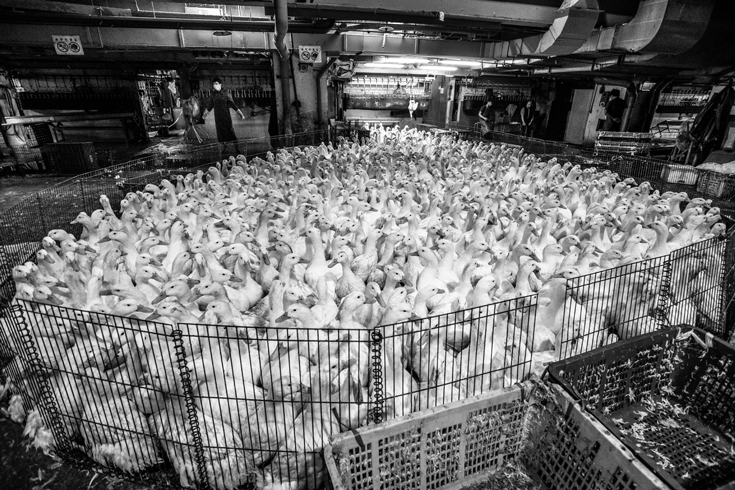
The lifespan of an activist is not usually long. They tire and burn out, and their idealism can fade. On the trip to the turkey farm, McArthur travelled with a small group of fellow investigators who were gathering video footage for a campaign. She realized that they were all about half her age. (To protect their work, McArthur won’t identify the name of the group, where they’re based, or even where exactly this particular farm is located.) The pandemic’s profound sadness notwithstanding, by preventing McArthur from travelling outside of Canada to work, it has given her a long-overdue rest. “I’ve had jet lag for the last fifteen years,” she says.
Bill 156, Ontario’s ag-gag bill, was another impediment, and it cast an undeniable chill. McArthur, a bit more wary now, currently has no immediate plans to work in Ontario. She’s frustrated that lawyers, like Labchuk, will now have to spend time and money fighting the bill in court. (Such laws in the US have routinely been struck down as unconstitutional, and Labchuk expects the same judicial response here.) But she’s also undaunted. Animal photojournalism is now being done all over the world. She has WAM contributors and donors everywhere. She has created an animal journalism “master class” that she says more than 300 people have taken. “Good luck stopping us,” she says.
Every year, it gets harder to justify consuming animals. Access to an unprecedented array of alternatives—from plant-based milks to test-tube meats—is increasing. We know that consuming animal products is a significant contributor to climate change. We know that eating and selling animals may lead to outbreaks of zoonotic viruses. We know that animals feel pain, experience loss, and have communication systems that we still don’t fully comprehend.
Yet, last year, in Canada, we killed 834 million land animals for food. Seeing what that process entails—what it truly looks like and what kind of suffering it requires—is crucial to understanding not only what we eat but the entire system producing that food. In Regarding the Pain of Others, Susan Sontag’s short book on war photography, she writes, “People don’t become inured to what they are shown—if that’s the right way to describe what happens—because of the quantity of the images dumped on them. It is passivity that dulls feeling.” Sontag is talking about images of human beings, of course, but the suffering she’s referring to is not unique to us. What is unique is the hierarchy that human beings have established in the world, one in which nature is subjugated to civilization, in which animal consciousness is somehow lesser than human consciousness, in which animal pain is different from human pain. It’s a hubristic category error and one that McArthur’s images try to correct. “We are all animals,” she says, “and we forget that.”


